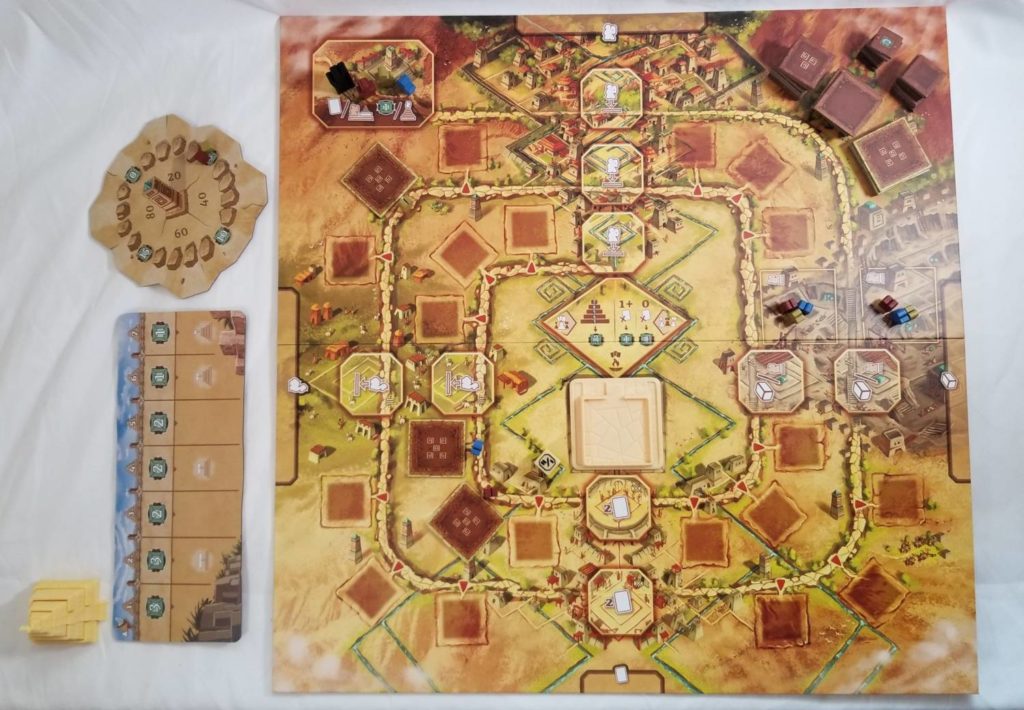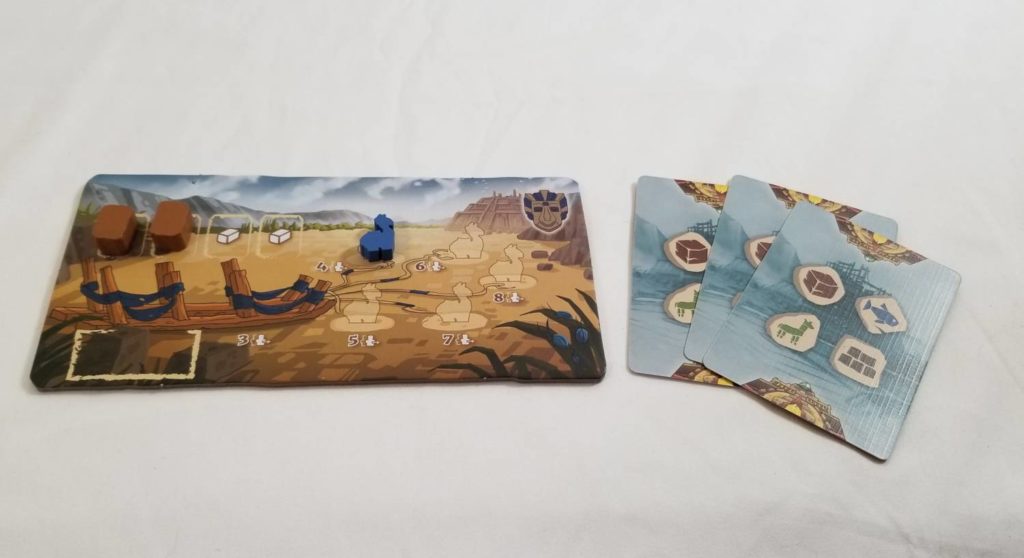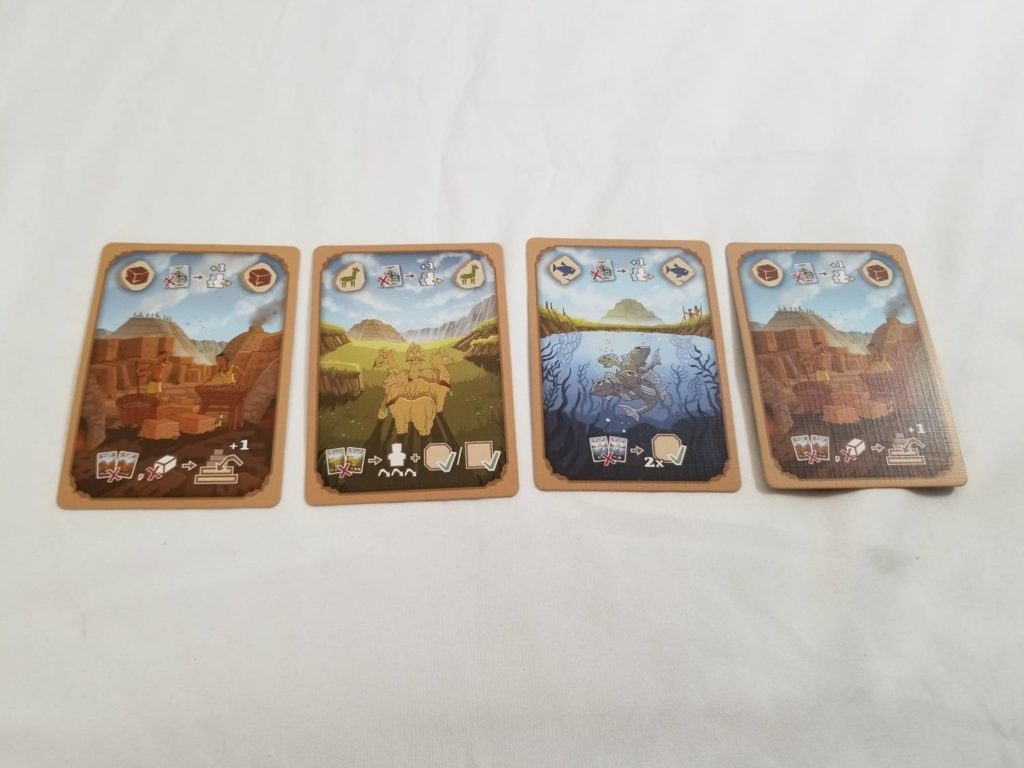Disclosure: Meeple Mountain received a free copy of this product in exchange for an honest, unbiased review. This review is not intended to be an endorsement.
According to Wikipedia: “The Sacred City of Caral-Supe, or simply Caral, is an archaeological site in Peru where the remains of the main city of the Caral civilization are found. It is located in the Supe valley of Peru, near the current town of Caral, 182 kilometers north of Lima, 23 km from the coast and 350 meters above sea level. It is attributed an antiquity of 5000 years and it is considered the oldest city in the Americas and one of the oldest in the world.”
The game of Caral, designed by Klaus-Jürgen Wrede (of Carcassonne fame), takes us back to a time in the titular city’s early history. The players take on the roles of builders tasked with erecting the city of Caral’s famed pyramids. As the game begins, the city is little more than barren patches of earth. But as the game goes on, the pyramids begin taking shape, creating a magnificent vista that any high priest could be proud of.
Overview
Caral takes place over the course of several game years, its pacing dictated by how quickly the players construct pyramids. The game is played on a spiraling track that is dotted with various Action spaces and Building Sites. At the start of a round, the Architect die is rolled and the Architect pawn is moved corresponding to the results. This not only serves as a round timer, but it also determines which actions the players are able to perform on their turns.
Players then move and take their actions. In general, a player selects from a limited set of actions: gain resources, deploy workers, increase movement, or develop pyramids. When the Architect (or a player) reaches the center of the board, an end-of-round scoring is performed, the game resets, and a new year begins. Once a total of seven pyramids have been constructed, the end game is triggered and that year is completed. Then final scoring is performed to determine the winner.
Of course, this is just a high-level overview of the game. If you think you’ve heard enough and just want to know what I think, feel free to skip ahead to the Thoughts section. Otherwise, read on as we learn how to play Caral.
Setup
A game of Caral is set up thusly:

First, determine the turn order by some means and give the Architect die to the first player. Shuffle the Resource cards to form a deck. Each player chooses a color and receives the following: the pieces and Transport sled of their chosen color, a Player aid, and, based on turn order, a number of stones and Resource cards. The pyramid sections are divided by size and set off to the side.
Next, the game board is laid out and the largest segment of the central pyramid is placed into the center of it. The deck of Resource cards is placed at the bottom of the board. The players’ alpaca pieces are placed to the left (minus the ones they begin the game with, which are placed onto their sleds). Their Carali figures are placed to the right of the board (minus any that were placed into the quarries during setup). Then, starting with the first player and moving clockwise, each player chooses a Building site, places one of their Carali figures in front of it, and places a size 5 pyramid base onto the selected location.

Place the Progress table off to the side along with the Fame scoreboard. Each player’s square Fame tracker begins on 0. The cylindrical Fame trackers are kept to the side of this board. They won’t be needed unless a player manages to score at least 20 points. Each player’s Player figure is placed onto the starting space of the spiral path on the main board. Then you’re ready to begin playing Caral.
Anatomy of a Year
Caral is played out over a series of years which are divided into a number of rounds. At the start of a year, players who have placed priests on top of any of their pyramids receive a victory point per priest. Then the Start player for that year rolls the Architect die and moves the Architect figure forward a number of Action spaces equal to the die’s result. In turn order, players take turns performing their movement phase followed by an action. The action the player is able to perform depends upon which Action space they decide to end their turn on. However, a player can only perform actions on spaces equal to or beyond the Architect’s position on the board.
Whenever a player or the Architect reaches the middle of the board, the year immediately comes to an end and an annual ceremony is performed. The player that triggered the ceremony receives the Architect die and becomes the new Start player for the following year. After the annual ceremony is complete, players receive cards based on how many pyramids—either completed or under construction—they have out on the board. Then, all the player figures are moved back to the starting space along with the Architect and a new year begins.
Movement and Actions
The distance a player can move their figure is dependent upon the alpacas connected to their Stone sled. At the start of the game, a player’s movement begins at a base of 4, but it can be increased to 8 by adding more alpacas to their team. This base movement can be extended by discarding Resource cards at a 1:1 rate. When moving a player’s figure, unlike the Architect, that player must stop at every Building site they encounter where at least one pyramid level has been constructed, and on every Action space. Fall too far behind the Architect and you may wind up having to take a turn in which you weren’t able to do anything.
As mentioned previously, the action a player performs depends on which space they end their movement. The Action spaces are:
Deploy Carali: Carali can be deployed to one of the two quarries, to an empty Building site in order to claim it, or as a priest to sit atop a completed 5-level pyramid.
Quarry: Collect stone equal to the number of your Carali that are deployed to the quarry, and store it on your Stone sled. Any you cannot store, due to going over max capacity, is lost.
Draw Cards: Draw 2 Resource cards from the deck and add them to your hand. There is no hand limit.
Add an Alpaca: Add an alpaca to your team. Each added alpaca increases your base movement by 1.
Construct a Pyramid Level: By ending your movement on a Building site on which you’ve previously placed one of your Carali, you can discard a stone from your Stone sled to begin a new pyramid or add to an existing one which has not been completed yet. At the beginning of pyramid construction, you must decide whether to begin construction on a level-3 or a level-5 pyramid. If adding a pyramid level should cause the pyramid to become complete, the player earns points from the Progress table based on how many pyramids have already been completed. This may also call for another level to be added to the central pyramid in the center of the board.

You may also perform additional actions by discarding matching pairs of Resource cards from your hand (the second way to use these cards), but you can only discard one of each pair per turn. Discarding two alpacas will allow you to move your Player figure up to 3 spaces and perform the action of whichever space you land on, discarding two fish will allow you to repeat the action of your current space, and discarding pairs of stone or clay cards will allow you to construct additional pyramid levels.
Scoring Points
The points you score during the game come from four sources: points awarded for completing pyramids; the annual ceremony; having priests at the beginning of a new year; and end-of-game scoring. I’ve already talked about the pyramids and the priests, so let’s go into some more detail about the other two.
![]()
When the annual ceremony is triggered, each player will have the opportunity to make a sacrifice by discarding resource cards from their hand, beginning with the person that triggered the ceremony. That person chooses any number of matching Resource cards (two alpacas, for instance) and places those Resource cards in front of them. The next player in line must then choose some other type of Resource card to give up (in this case, something other than alpacas). This continues until every player has sacrificed some number of Resource cards that are different from those the other players have sacrificed. The player that sacrificed the most cards earns a bonus based on how many levels there are in the central pyramid. Everyone else that sacrificed at least one Resource card earns a point. Players that did not sacrifice anything (because they could not or did not want to) will lose a point instead.

The game ends at the end of the year in which the seventh pyramid was completed. After performing the annual ceremony for that year, end-of-game scoring is performed. Players earn 2 points for each of their priests, points for their completed pyramids (5 points for level-3 pyramids and 10 for level-5s), and a single point for each level of any incomplete pyramids. This total is added to any points the players have collected during the game and the person with the highest total wins.
Thoughts
Last year, I had the opportunity to review Klaus-Jürgen Wrede’s previous game Fire & Stone, a game which left me feeling a bit conflicted. My first experience with the game was a miserable one with subsequent plays being far less so. That game featured a lot of randomness and there wasn’t a whole lot you could do to mitigate any of it. Like its predecessor, Caral features a bit of randomness in the form of the Architect die and the Resource card deck. Would the game’s luck factor feature a prominent role or, like the conveyor belt of a sushi train, would it serve as a conveyance for more interesting decisions?
There was only one way to find out. When Meeple Mountain was offered a review copy, I raised my hand.
I’d first heard about Caral during its Kickstarter campaign. I remember thinking at the time that, as much as I was interested in playing it, the production value with all of the little plastic pyramids seemed a bit over the top. I’d feared that having all that plastic everywhere would interfere with visibility and obscure important game information. By contrast, the retail version of the game that I was supplied with feels a lot more tastefully done. Minus the central pyramid, the plastic pyramids have all been replaced with cardboard tiles. They still look great on the table while simultaneously presenting zero visibility issues.
The rest of the game looks great as well. Hendrik Noack, the artist for Fire and Stone, returns for another KJW team-up and he doesn’t disappoint. This is also not his first run in with Funtails either. Hendrik Noack has done the artwork for every game that Funtails has released thus far, and it all looks fantastic. Hendrik manages to occupy the space in the middle of a Venn diagram where cartoony, stylish, and detailed overlap, and he occupies it well. He’s definitely an artist to keep an eye on!
Going into my first play of the game, I was feeling equal parts hopeful and trepidacious. My hopes were that my decisions would matter, that my well-laid plans wouldn’t be undone by some unfortunate die roll or flip of a card. My fears were that they would be.
As it turns out, those fears were unfounded. Without that little bit of luck, Caral would simply not work, because Caral, as it turns out, is all about pushing your luck.
Fundamentally, Caral is a game about trying to eke out as much productivity as you possibly can before someone triggers the annual ceremony to bring the year to an end. This creates a lot of tension on your turn as you try to decide what to do. When you take your movement, you always have the ability to move backwards along the track, so it’s tempting to jump way ahead of the Architect to do something and then double-back to do something else so that you can then take that action you leapt ahead to for a second time. But the efficacy of such a strategy is entirely contingent upon the Architect’s movement and the person controlling that movement.
Will the current Start player race for the middle so that they can control the pacing? Or will they take it slow so that they can accomplish more? If you race too far ahead of the Architect, there’s a very good chance that it may pass up whatever you were hoping to double back to pick up later. So, maybe you should grab whatever that is now while you still have the chance.

It’s also worth considering that the player that triggers the annual ceremony also starts the sacrifice round. Oftentimes, you’ll find yourself with only one or two cards in hand staring down the barrel of a fast approaching sacrifice round. If you’re the one getting the proceedings started, the situation’s not so precarious. But if it’s a four-player game and you’re last in line, unless you’re prepared with at least one of each type of card, there’s a good chance you’re going to get shut out and wind up losing some points. Do you risk that and focus on other things? Or do you give obtaining cards precedence over everything else? Or, perhaps you make a determined effort to become the new Start player, leaving everyone else in the lurch instead.
Caral is awash with these types of tense on-the-spot decision making moments, and none of them are easy. There is no single path to victory. Every strategy is viable and the game is better for it.
The only negative thing that I have to say about Caral is that there are a few clarity issues that arise each time I play the game, and the group always winds up having to house rule the way that things play out as a result. For instance, the rules for playing pairs of stone/clay cards from your hand state: “You may immediately build an additional pyramid level.” While the rules do state that you can only carry out the different actions at the location on which your pawn is located, these Resource card abilities are listed in their own section. So, do these Resource cards allow you to add pyramid levels to other sites including ones where you may have built zero levels? It’s anybody’s guess.
There are a couple more instances of this rules-fuzziness, but none are as critical as the example presented. Overall, though, once your group has come to a consensus as to how these things can be played, it really doesn’t affect the gameplay very much. That being said, in my opinion, you should never have to come to a consensus when it comes to playing a rule in a game correctly.
Putting that aside, Caral is a very enjoyable game. The rules are simple and easy to understand. Turns move by quickly, so you’re never left waiting for very long. There’s just enough player interaction to keep you feeling engaged. The choices are interesting and your decisions matter. The artwork is stellar. Plus, it’s just a lot of fun.
If that sounds appealing to you, you should definitely give Caral a try. I’m sure it’d really please the high priest if you did. You wouldn’t want to displease the high priest, would you?
Would you?!











Add Comment